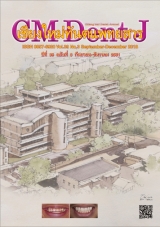Basic Knowledges of Finite Element Method and Application in Implant Dentistry
Main Article Content
Abstract
Finite element analysis (FEA) is a mathematical technique which is the approximate model solutions of partial differentiate equations. This technique is not only commonly used in engineering, but also has been applied in several multidisciplinary sciences, including biomechanical investigation in dental materials and the distribution pattern of stress and strain that generated from oral function. This method is useful for improving in material design and studying the harmonization of material to living tissue. It is repeatable, low producing cost, comfortable to simulate and develop a positive end result.
This literature explains and emphasizes on the basic knowledge of FEA, including FEA methodology, mechanical behaviors of the material and its application focusing in implant dentistry field.
Article Details
References
ปราโมทย์ เดชะอำไพ. ตำราวิศวฯ 100 ปี 2456-2556 ไฟไนต์เอลิเมนต์ในงานวิศวกรรม. สำนักพิมพ์แห่งจุฬาลงกรณ์มหาวิทยาลัย; 2555: 1-5.
Thresher RW, Saito GE. The stress analysis of human teeth. J Biomech 1973; 6(5): 443-449.
Weinstein AM, Klawitter JJ, Anand SC, Schuessler R. Stress analysis of porous rooted dental implants. J Dent Res 1976; 55(5): 772-777.
Trivedi S. Finite element analysis: A boon to dentistry. J Oral Biol Craniofac Res 2014; 4(3): 200-203.
Mohammed SD, Desai H. Basic Concepts of Finite Element Analysis and its Applications in Dentistry: An Overview. Journal of Oral Hygiene & Health 2014; 2(5): 1-5.
Wakabayashi N, Ona M, Suzuki T, Igarashi Y. Nonlinear finite element analyses: advances and challenges in dental applications. Journal of Dentistry 2008; 36(7): 463-471.
Sato Y, Shindoi N, Koretake K, Hosokawa R. The effect of occlusal rest size and shape on yield strength. J Prosthet Dent 2003; 89(5): 503-507.
Grbović A, Mihajlović D. Practical Aspects of Finite Element Method Applications in Dentistry. Balk J Dent Med 2017; 21(2): 69-77.
Kestel P, Schneyer T, Wartzack S. Feature-based approach for the automated setup of accurate, design-accompanying Finite Element Analyses. DS 84: Proceedings of the DESIGN 2016 14th International Design Conference. 2016.
Murakami N, Wakabayashi N. Finite element contact analysis as a critical technique in dental biomechanics: a review. J Prosthodont Res 2014; 58(2): 92-101.
Moeen F, Nisar S, Dar N. A step by step guide to Finite Element Analysis in dental implantology. Pakistan Oral & Dental Journal 2014; 34(1): 164-169.
Geng J, Yan W, Xu W. Application of the finite element method in implant dentistry. Springer Science & Business Media; 2008: 82-90.
Rao SS. The finite element method in engineering. 5th ed. Elsevier; 2010: 53-60.
Desai Shrikar R, Shinde Harshada H. Finite Element Analysis: Basics And Its Applications In Dentistry. Indian J Dent Sci 2012; 4(1): 60-65.
Gallagher RH. Finite element analysis: fundamentals. Prentice-Hall Civil Engineering and Engineering Mechanics Series. 4th ed. Englewood Cliffs: Prentice-Hall; 1975: 1-19.
Chopade SR, Madhav VV, Palaskar J. Finite element analysis: New dimension in prosthodontic research. J Dent Allied Sci 2014; 3(2): 85-88.
Chen X, Liu Y. Finite element modeling and simulation with ANSYS Workbench: CRC Press. 2014.
Soman P. Mechanical modeling of intraneural ganglion cyst: Master's thesis Michigan Technological University. 2012. http://digitalcommons.mtu.edu/cgi/viewcontent.cgi?article=1409&context=etds
Liu Y, Glass G. Effects of Mesh Density on Finite Element Analysis. SAE International Paper. 2013. https://www.researchgate.net/publication/262525548_Effects_of_Mesh_
Density_on_Finite_Element_Analysis
Ebrahimi F. Finite Element Analysis New Trends and Developments. 2nd ed. Intech. chapters 2; 2012: 21-47.
Olmsted M, Wall C, Vinyard C, Hylander W. Human bite force: the relation between EMG activity and bite force at a standardized gape. Am J Phys Anthropol 2005: WILEY-LISS DIV JOHN WILEY & SONS INC, 111 RIVER ST, OBOKEN, NJ 07030 USA.
Rangert B, Jemt T. Forces and Moments on Brånemark Implants. Int J Oral Maxillofac Implants 1989; 4(3): 241-247.
Mericske ‐ stern R, Piotti M, Sirtes G. 3‐D in vivo force measurements on mandibular implants supporting overdentures. A comparative study. Clin Oral Implants Res 1996; 7(4): 387-396.
Rungsiyakull C, Rungsiyakull P, Li Q, Li W, Swain M. Effects of occlusal inclination and loading on mandibular bone remodeling: a finite element study. Int J Oral Maxillofac Implants 2011; 26(3): 527-537.
Chen J, Li W, Swain MV, Darendeliler MA, Li Q. A periodontal ligament driven remodeling algorithm for orthodontic tooth movement. J Biomech 2014; 47(7): 1689-1695.
Dejak B, Młotkowski A. Finite element analysis of strength and adhesion of cast posts compared to glass fiber-reinforced composite resin posts in anterior teeth. J Prosthet Dent 2011; 105(2): 115-126.
Geng J-PA, Tan KBC, Liu GR. Application of finite element analysis in implant dentistry: a review of the literature. J Prosthet Dent 2001; 85(6): 585-598.


